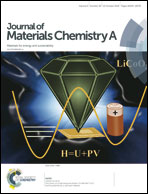Highly conjugated poly(N-heteroacene) nanofibers for reversible Na storage with ultra-high capacity and a long cycle life†
Abstract
Rechargeable Na-ion batteries based on redox-active polymers are highly desirable for the next generation of “green batteries”. This study offers a simple and effective approach for the development of high performance organic anodes by introducing aromatic N atoms into conducting polymer backbones. Herein, for the first time, cyclized polyacrylonitrile (cPAN) is studied as a model of N-containing polyacene (PAc) and investigated as a novel organic anode. Benefiting from the highly conjugated backbones with rich C![[double bond, length as m-dash]](https://www.rsc.org/images/entities/char_e001.gif) N groups, the cPAN nanofibers demonstrate superior Na storage performances including high reversible capacity (527 mA h g−1 at 50 mA g−1), outstanding rate capability (200 mA h g−1 at 5 A g−1) and an ultra-long lifespan (capacity retention of 99.4% over 3500 cycles). Ex situ structural characterization combined with theoretical calculations reveals that the introduction of aromatic N atoms with lone pair electrons could not only reduce the energy gaps of the PAc backbones, but also act as the redox-active centers. The results are promising and may pave the way towards the rational design of novel redox-active polymers for various energy storage applications.
N groups, the cPAN nanofibers demonstrate superior Na storage performances including high reversible capacity (527 mA h g−1 at 50 mA g−1), outstanding rate capability (200 mA h g−1 at 5 A g−1) and an ultra-long lifespan (capacity retention of 99.4% over 3500 cycles). Ex situ structural characterization combined with theoretical calculations reveals that the introduction of aromatic N atoms with lone pair electrons could not only reduce the energy gaps of the PAc backbones, but also act as the redox-active centers. The results are promising and may pave the way towards the rational design of novel redox-active polymers for various energy storage applications.



 Please wait while we load your content...
Please wait while we load your content...